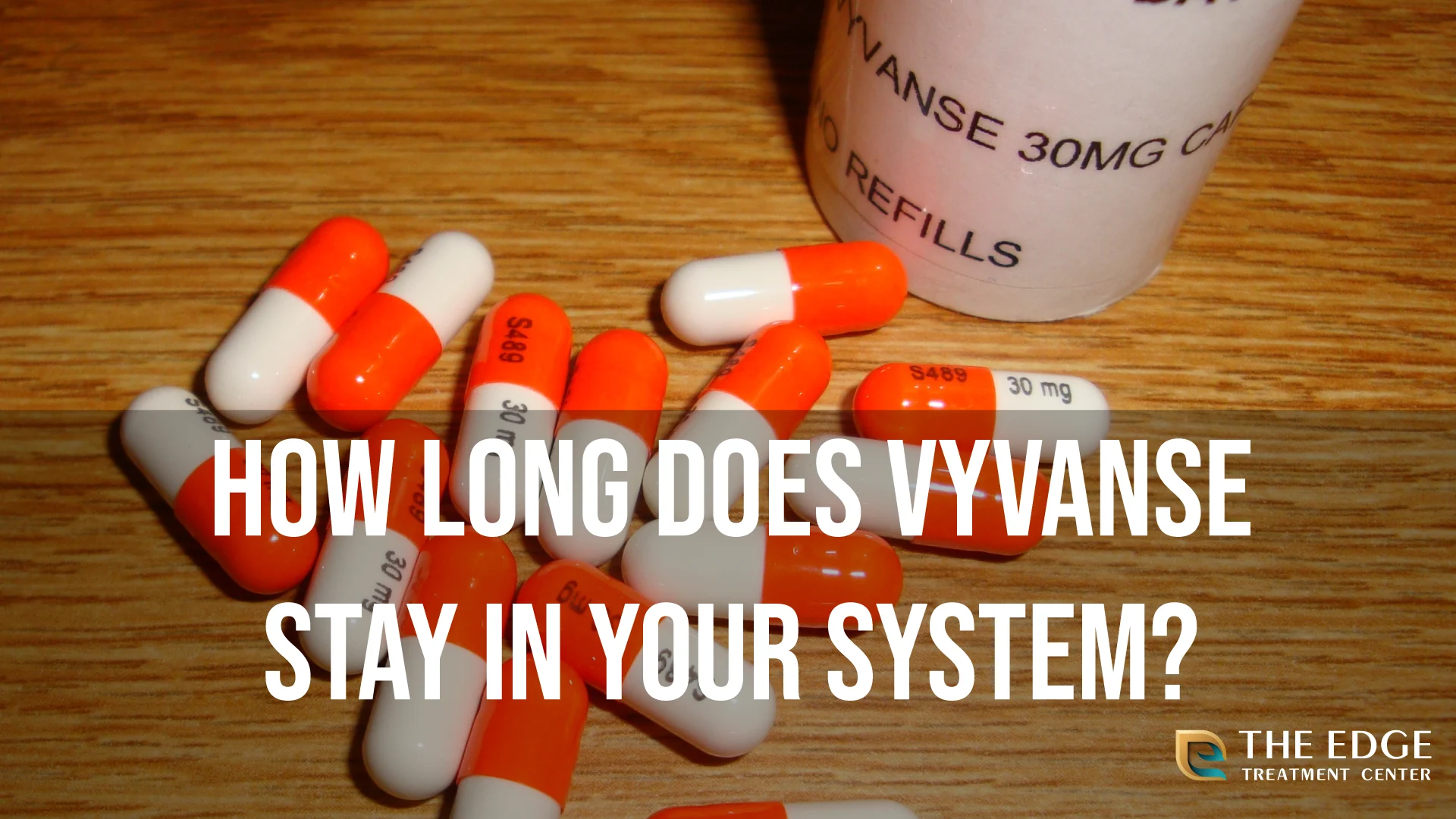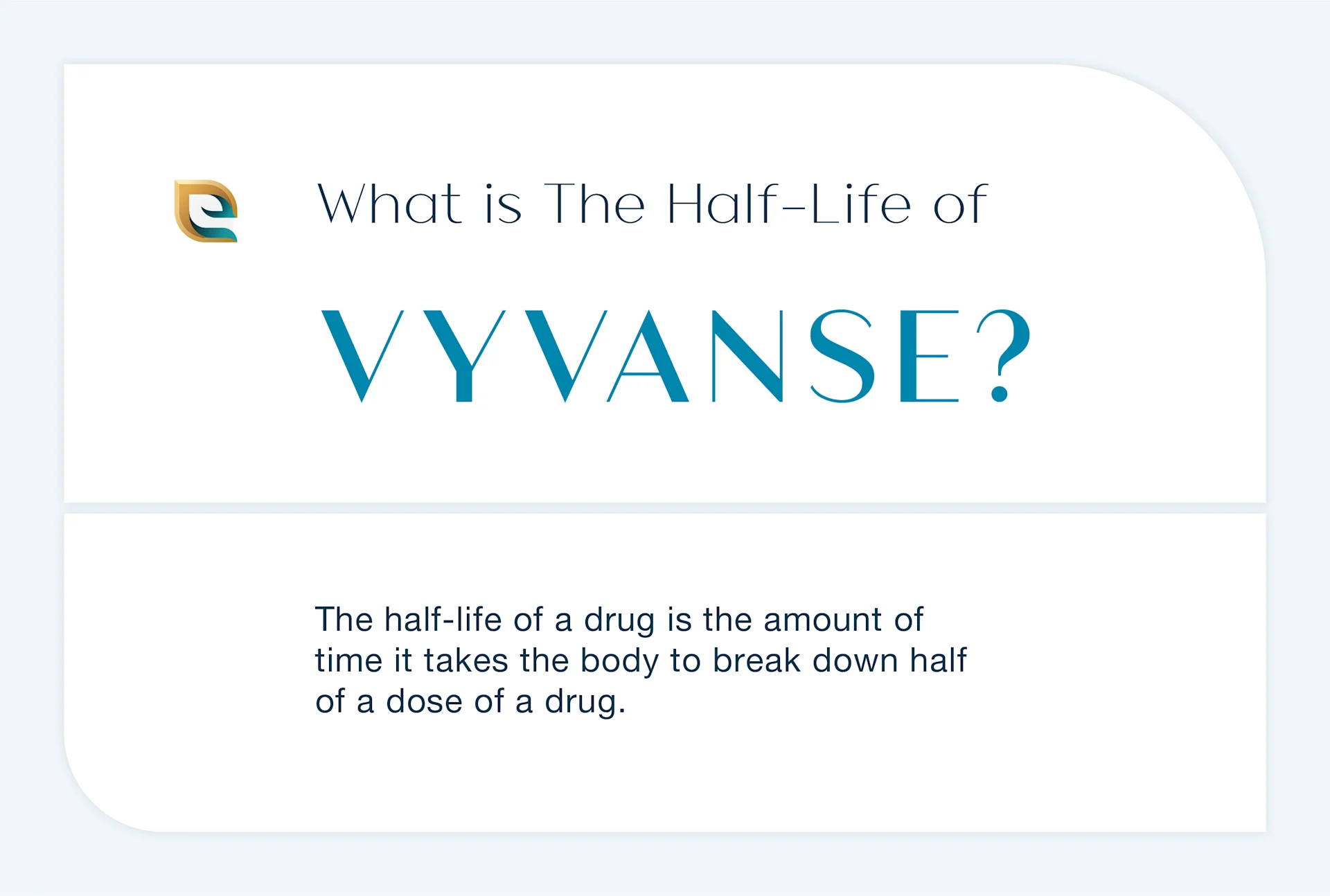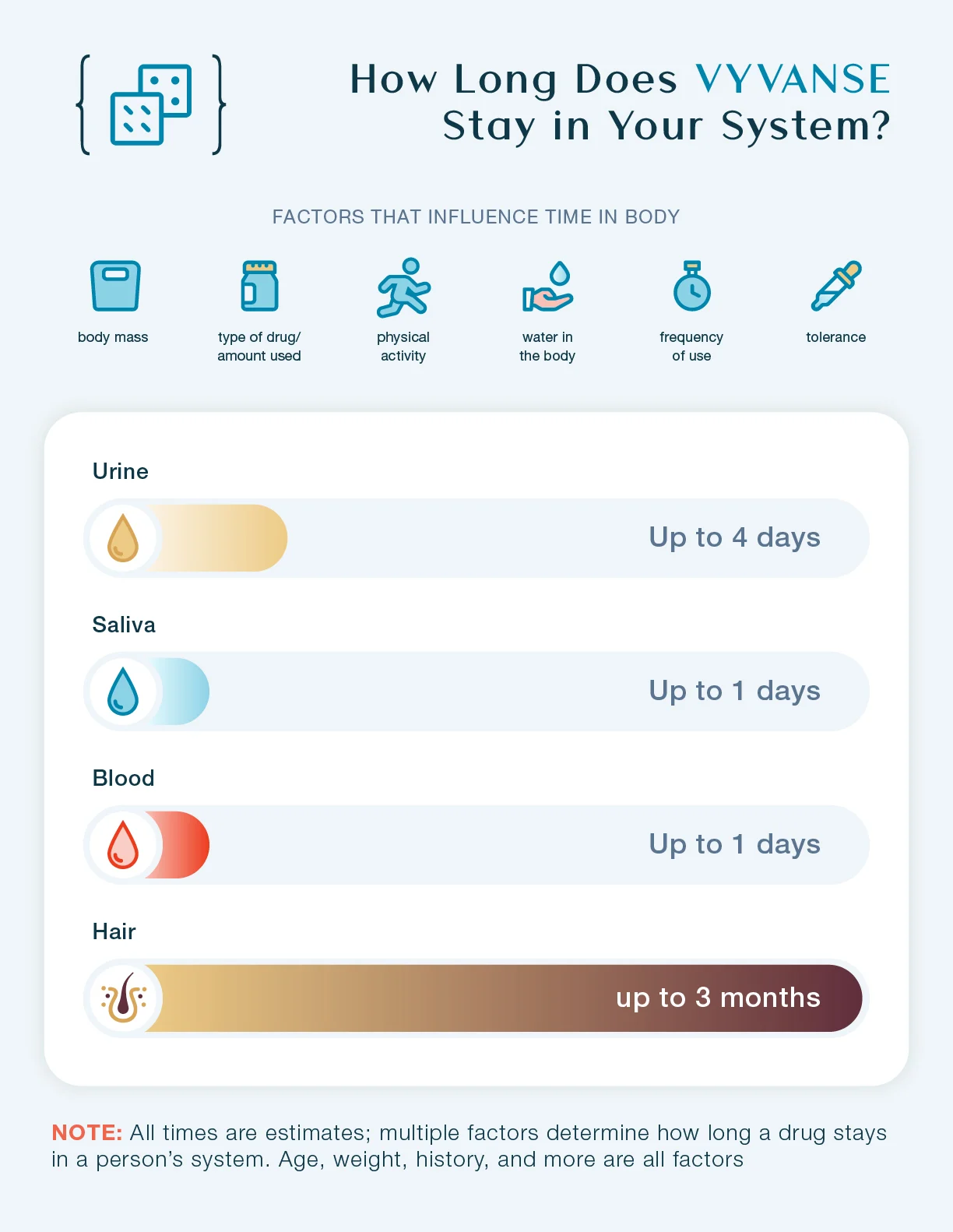Drug and Alcohol
How Long Does Vyvanse Stay in Your System?

Ever wonder how long Vyvanse stays in your system? Our blog answers this question and more. Learn more about Vyvanse addiction in our blog.
While Vyvanse (and other drugs like it, such as Adderall) can be an effective treatment for attention-deficit/hyperactivity disorder (ADHD) when used as directed, there has been an increase in its abuse in the USA.
Abuse of Vyvanse typically involves taking the medication in larger doses, more frequently than prescribed, or taking it without a prescription. This can lead to a number of negative consequences, including addiction, cardiovascular problems, psychosis, and other mental health issues.
One reason for the rise in Vyvanse abuse is that it can produce a euphoric high when taken in large doses. In addition, some individuals abuse Vyvanse as a so-called "study drug," hoping to improve their academic performance or work productivity. The increase in Vyvanse abuse is also part of a larger trend of prescription drug abuse in the USA.
Many people who abuse prescription drugs obtain them from friends or family members with legitimate prescriptions. To address the problem of Vyvanse abuse, it is essential for healthcare providers to carefully screen patients for ADHD and other conditions before prescribing the medication.
By the Numbers
According to data from the Diagnostic and Statistical Manual of Mental Disorders, around 9% of American kids between the ages of 8 and 15 who were included in the study fulfilled the clinical criteria for ADHD.
What Is Vyvanse?
Vyvanse (Lisdexamfetamine) is a prescription medication that belongs to a class of drugs known as central nervous system (CNS) stimulants. It is commonly used to treat attention-deficit/hyperactivity disorder (ADHD) and binge eating disorder (BED).
Vyvanse works by increasing the neurotransmitters in the brain: dopamine and norepinephrine. These chemicals play a key role in regulating attention, behavior, and impulse control, which is often impaired in individuals with ADHD and BED.
Vyvanse is a prodrug, which means it is not active until the body metabolizes it into its active form, dextroamphetamine. This slower metabolism allows for a longer-lasting effect of the medication, which can last up to 12 hours in some individuals.
Vyvanse is available in capsule form and is typically taken once daily in the morning. The dose of the medication varies based on individual factors, such as age, weight, and the severity of the condition being treated. Therefore, it is important to follow the dosage instructions provided by a healthcare provider.
Like any medication, Vyvanse has the potential for side effects. Some common side effects include loss of appetite, trouble sleeping, headache, dry mouth, and stomach pain. In rare cases, Vyvanse can also lead to more serious side effects such as heart problems, hallucinations, and seizures.
Vyvanse is a controlled substance, meaning it has the potential for abuse and dependence. Therefore, it is essential to take the medication only as prescribed and to store it in a safe place to prevent misuse by others. If someone has a history of drug abuse or addiction, they should talk to their healthcare provider before taking Vyvanse.
Thus, Vyvanse is a CNS stimulant medication for treating ADHD and BED. It works by increasing the levels of dopamine and norepinephrine in the brain and is available in capsule form.
What Is Vyvanse's Half-Life?
Vyvanse (Lisdexamfetamine) is a prescription medication used to treat attention deficit hyperactivity disorder (ADHD) and binge eating disorder. It belongs to a class of drugs called central nervous system (CNS) stimulants.
A drug's half-life is when it takes half of the drug to be eliminated from the body. It measures how long a drug remains active in the body. For example, the half-life of Vyvanse is the time it takes for 50% of the drug to be eliminated from the body.
The half-life of Vyvanse can vary from person to person and can depend on factors such as age, weight, liver function, kidney function, and other medical conditions. However, on average, the half-life of Vyvanse is around 10-12 hours. So, for example, if you take a 30 mg dose of Vyvanse, it will take approximately 10-12 hours for half of the drug to be eliminated from your body.
The effects of Vyvanse may last longer than its half-life. This is because Vyvanse is a prodrug, which means that it is inactive until the body metabolizes it into its active form, dextroamphetamine. As a result, the effects of Vyvanse can last up to 14 hours in some individuals.
It is advised to take Vyvanse early in the day to avoid insomnia or sleep disturbances. It is also important to follow your doctor's instructions and not exceed the recommended dose or duration of treatment, as this can increase the risk of side effects and dependence.


We’re Here To Help You Find Your Way
Would you like more information about how long Vyvanse stays in your system? Reach out today.
How Does Vyvanse Work?
Vyvanse is a prescription medication commonly used to treat attention deficit hyperactivity disorder (ADHD) and binge eating disorder. The active ingredient in Vyvanse is lisdexamfetamine, which is a prodrug of dextroamphetamine. This means that lisdexamfetamine is metabolized in the body into dextroamphetamine, which is the active form of the medication.
Vyvanse works by increasing the levels of neurotransmitters in the brain, particularly dopamine, and norepinephrine. These neurotransmitters regulate attention, motivation, and pleasure, and their increased availability can help improve focus, concentration, and mood.
When Vyvanse is taken orally, it is broken down in the digestive system and converted into l-lysine and dextroamphetamine. The dextroamphetamine is then absorbed into the bloodstream and transported to the brain, where it increases the levels of dopamine and norepinephrine by binding to and blocking the reuptake of these neurotransmitters by the neurons.
This increases the availability of these neurotransmitters in the brain, which can improve attention, focus, and impulse control in people with ADHD. It can also reduce the symptoms of binge eating disorder by decreasing the urge to eat and increasing feelings of fullness. Vyvanse is a controlled substance because it has the potential for abuse and dependence.
How Is Vyvanse Detected in the Body?
Vyvanse (lisdexamfetamine) can be detected in the body through various methods, including urine, blood, hair, and saliva testing. The detection duration depends on several factors, such as the dose, frequency of use, metabolism, and individual variability.

Urine Testing for Vyvanse
Urine testing is the most common method used to detect Vyvanse, and it can detect the presence of the drug and its metabolites for up to 2-4 days after the last dose. However, with prolonged use or high doses, Vyvanse may remain detectable in urine for up to a week or more.
Blood Testing for Vyvanse
Blood testing can also detect Vyvanse and its metabolites, but it is less commonly used than urine testing. Blood testing can detect the drug for up to 24 hours after the last dose, but the detection window may vary depending on the individual and the dose.
Hair Testing for Vyvanse
Hair testing is a less common but more sensitive method of detecting the presence of Vyvanse. It can detect the drug for up to 90 days after the last dose, depending on the length of hair and the dose of Vyvanse used.
Saliva Testing for Vyvanse
Saliva testing is also a relatively new and less common method of detecting Vyvanse in the body. Saliva testing can detect the drug for up to 24 hours after the last dose.

We’ll Lead You to New Heights
Do you have more questions about how long Vyvanse stays in your system? Reach out.
How Long Does Vyvanse Stay in the System?
Vyvanse is a prescription medication that contains lisdexamfetamine dimesylate, which is a stimulant drug that is primarily used to treat attention-deficit/hyperactivity disorder (ADHD) and binge eating disorder. Like other medications, Vyvanse is metabolized by the body and eventually eliminated from the system. However, the length of time that Vyvanse stays in the system can vary depending on various factors.
The half-life of Vyvanse is approximately 10-12 hours, which means it takes about that amount of time for half of the drug to be eliminated from the body. However, it can take longer for the drug to be eliminated from the system as the body continues to metabolize the drug and excrete it through urine and feces.
Several factors can influence how long Vyvanse stays in the system, including:
Dosage
The higher the dosage of Vyvanse, the longer it may take for the drug to be eliminated from the system.
Age
Older individuals may metabolize drugs more slowly, which could result in Vyvanse staying in the system longer.
Body Mass
Individuals with higher body mass may metabolize drugs more slowly, which could result in Vyvanse staying in the system longer.
Liver and Kidney Function
Individuals with impaired liver or kidney function may metabolize drugs more slowly, which could result in Vyvanse staying in the system longer.
Hydration
Drinking plenty of water can help to flush the drug out of the system more quickly.
Generally, it takes about 2-3 days for Vyvanse to be eliminated from the system.
What Are the Symptoms of Addiction to Vyvanse?
Vyvanse is a prescription for attention-deficit/hyperactivity disorder (ADHD). While it can be an effective treatment for these conditions, it also has the potential for abuse and addiction. Vyvanse contains the active ingredient lisdexamfetamine, a stimulant that can cause changes in brain chemistry that lead to addiction.
The symptoms of addiction to Vyvanse can vary from person to person, but there are some common signs to look out for:
Drug Cravings
A person addicted to Vyvanse may experience strong cravings for the drug, even when they don't need it for a medical condition. These cravings can be difficult to resist and can lead to compulsive drug-seeking behavior.
Tolerance
Over time, a person who is addicted to Vyvanse may need to take higher doses of the drug to achieve the same effects. This is known as tolerance, and it can be a sign that the brain is becoming dependent on the drug.
Withdrawal Symptoms
If a person stops taking Vyvanse suddenly, they may experience withdrawal symptoms such as fatigue, depression, irritability, and insomnia. These symptoms can be uncomfortable and can lead a person to continue using the drug to avoid them.
Obsessive Behavior
Addiction to Vyvanse can cause a person to become obsessive about their drug use. They may spend a lot of time thinking about the drug, planning how to get it, and using it.
Social Withdrawal
A person who is addicted to Vyvanse may start to withdraw from friends and family and lose interest in activities they used to enjoy. They may also start to neglect their responsibilities at work, school, or home.
Physical Symptoms
Besides psychological symptoms, addiction to Vyvanse can cause physical symptoms such as increased heart rate, high blood pressure, and weight loss.
Continued Use Despite Negative Consequences
A person addicted to Vyvanse may continue to use the drug even when it causes negative consequences such as financial problems, relationship issues, or legal troubles.

We’re Here To Help You Find Your Way
Do you need advice about how long Vyvanse stays in your system? Reach out today.
Treatment of Addiction to Vyvanse
Treating addiction to Vyvanse involves a combination of behavioral therapy, medication-assisted treatment, and support from family and friends.
Behavioral Therapy
Behavioral therapy is a vital component of addiction treatment. Cognitive-behavioral therapy (CBT) and contingency management (CM) are two of the most effective approaches for treating addiction to Vyvanse. CBT helps individuals understand the thoughts and behaviors that lead to drug use and develop coping strategies to avoid or manage them. CM is a reward-based therapy that provides incentives for remaining drug-free. In addition, both therapies can help individuals address underlying mental health conditions contributing to their addiction.
Medication-Assisted Treatment (MAT)
Medication-assisted treatment (MAT) is an evidence-based approach to treating addiction that involves the use of medication to reduce cravings and withdrawal symptoms. In the case of Vyvanse addiction, the medication may include methadone or buprenorphine. These medications can help individuals stay on track with their recovery and reduce the risk of relapse.
Support From Family and Friends
Addiction is a complex and challenging condition that can be difficult to overcome alone. Family and friends can play a crucial role in supporting individuals with an addiction to Vyvanse. This can include providing emotional support, helping with daily activities, and encouraging participation in treatment.
Lifestyle Changes
Making healthy lifestyle changes is essential for individuals in recovery from Vyvanse addiction. This includes getting enough sleep, eating a healthy diet, exercising regularly, and avoiding triggers that may lead to drug use.
Continued Care
Addiction is a chronic condition that requires ongoing care and support. Individuals in recovery from Vyvanse addiction may benefit from continued therapy, support groups, and regular check-ins with their healthcare provider.
Thus, treating addiction to Vyvanse involves a combination of behavioral therapy, medication-assisted treatment, support from family and friends, lifestyle changes, and continued care.
Vyvanse Addiction Is Treatable at The Edge Treatment Center
The Edge Treatment Center specializes in helping individuals overcome Vyvanse addiction. We offer a variety of evidence-based treatments and therapies that can help individuals break free from the cycle of addiction and regain control of their lives.
In addition to therapy, The Edge Treatment Center also offers medication-assisted treatment (MAT). MAT involves using medications, such as buprenorphine or naltrexone, to help manage cravings and reduce the risk of relapse. MAT is often used in conjunction with therapy for the best outcomes.
Vyvanse addiction is treatable. Contact The Edge Treatment Center today to learn more.

We’re Here To Help You Find Your Way
If you or a loved one is struggling with addiction, there is hope. Our team can guide you on your journey to recovery. Call us today.
Written by
 Brian Moore
Brian MooreContent Writer
Reviewed by
 Jeremy Arzt
Jeremy ArztChief Clinical Officer
Drug and Alcohol
February 11, 2025
